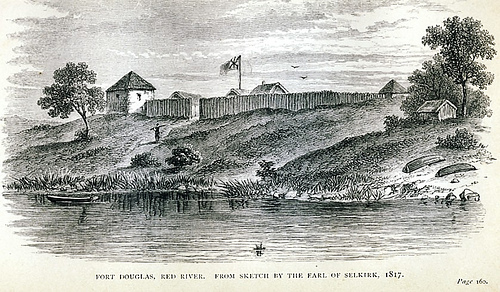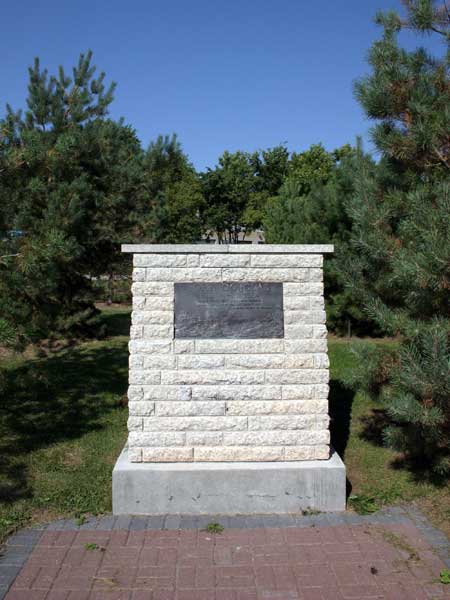Fort Douglas, Canada
 |
 |
| Fort Douglas Cairn, Winipeg |
 |
| This plaque, located near the Alexander Docks between
Waterfront Drive and the Red River, features a sketch of
Fort Douglas made by Lord Selkirk during his visit to the
Red River Settlement in 1817. |
Fort Douglas was a fort of the Hudson's Bay Company that was built
by Scottish and Irish settlers in 1812 in what is today Winnipeg,
Manitoba. It was in the immediate vicinity (down river) of the North
West Company establishment, Fort Gibraltar.
During the
conflict between the Hudson's Bay Company and the North West
Company, the fort was burned by the Métis and employees of the North
West Company. The fort was soon rebuilt and there was a short period
of relative peace. It was used as a trading post.
In 1812,
Miles Macdonell established the headquarters of the Red River
Settlement nearby on Point Douglas. Named for
Thomas Douglas, 5th Earl of
Selkirk, it was also the Hudson’s Bay Company’s first post in
this area.
In 1816, Cuthbert Grant’s Métis seized the fort
for the Nor’Westers, whose own Fort Gibraltar had been burned by
Governor Semple, but Selkirk recaptured it that summer. After the
Battle of Seven Oaks in 1816, the fort was again destroyed, and the
settlers were removed from their land.
After the union of
1821, the Hudson’s Bay Company occupied the rebuilt Fort Gibraltar
(renamed Fort Garry) and Fort Douglas remained the residence of the
Governor of the settlement until it was destroyed in the flood of
1826.
A different perspective
During the war of 1812, a group of white invaders led by Thomas
Douglas, 5th Earl of Selkirk, thought they had the right to invade
Anishinabe land in Manitoba, Ontario, Saskatchewan, Minnesota, North
Dakota, and South Dakota. They refer to the illegal land grant they
illegally purchased through the Hudson Bay Company as, Assiniboia. Their
actions were learned of by the Anishinabe Nation. White historians refer
to them as the Metis who they claim were a mixed Indian-white people.
The Metis were really a totem of the Anishinabe people. They were known
as the Mitewiwin or Medicine Society. Metis is pronounced as May-Tay.
Mitewiwin is pronounced as Mi-Tay-Wi-Win. The whites dropped the "wiwin"
and simply called the members of this Anishinabe totem, the Mitay.
During the War of 1812, the whites knew they would win the conflict
and early on conspired to invade the Manitoba region. Their goals were
to steal Anishinabe land and kill off the wild game which roamed
throughout that region. In 1811, Selkirk led a small group of white
invaders to the region around what is now Winnipeg and illegally
established the Red River Colony (Assiniboia). In 1809 the white
invaders built Fort Gibralter. In 1812 they built Fort Douglas. This is
the part of this obvious conspired event Anishinabe people must read
carefully. Supposedly Selkirk did not want the Northwest Trade Company
competing for furs with the Hudson Bay Company. Both the white trade
companies were conspiring to steal Anishinabe land at the time.
Anishinabe ogimak knew exactly what that meant. They not only had to
deal with the Northwest Trade Company trappers but also the trappers
from the Hudson Bay Company.
However, very few white trappers
dared to trap on Anishinabe land. If they did and were caught, chances
were they were executed. Anishinabe ogimak knew from prophecy that the
whites would kill off the wild game which roamed their land. Anishinabe
ogimak did allow the whites to travel to certain areas in Anishinabe
land to pick up furs trapped for by Indian trappers. A group of 128
white men led by Miles McDonald, attempted to start the colony in 1812.
They invaded by way of York Factory which was located next to Hudson
Bay. By August 30, 1812 they arrived to the vicinity of Fort Gibralter
(Winnipeg) and set camp. By that date they only numbered 35. McDonald
supposedly said to the west of Red River, the land was a plain (did not
have trees), while to the east of Red River, the land was covered by
trees. McDonald also lied about the nature of that land. He said the
land was unsettled. At the time (1812) perhaps 1,000s if not 10,000s of
Anishinabek, lived around what is now the Winnipeg region.
McDonald is Arrested
With Fort Gibralter there for protection,
the white invaders led by McDonald, commenced to start farms and send
for more white invaders. Their actions were learned of by Anishinabe
ogimak who cut off supply routes to force the white invaders to change
their policy. In responce to the Anishinabe blockade, McDonald tried to
break through the blockade. They refer to it as the Pemmican
Proclamation. The white invaders actions led to Anishinabe military
commanders arresting McDonald. McDonald was forced to go to Montreal.
McDonald was fortunate to not have been executed for his illegal
actions.
The Battle of Red River
After McDonald was
arrested and forced to go to Montreal, ogima Little Shell II (ogima
Little Shell I had been killed in a battle nearly a decade earlier near
Spirit Lake, North Dakota), or possibly another Anishinabe ogima (ogima
Little Shell II may have been very young when this battle was fought),
ordered an Anishinabe military commander to lead a force of Anishinabe
soldiers to the site of the unwanted white settlement i'll name Red
River. At the time some 140 whites were living there. Upon arriving to
the white invaders town of Red River, Anishinabe soldiers commenced to
attacking the settlement, as well as burning their crops, and also
destroying their homes. Historians claim that 60 white invaders were
forced to go back to Jack River to wait for an arrival of a new larger
group of white invaders led by Robert Semple, after this battle. White
casualties were 80 or more killed and wounded. Anishinabe casualties are
unknown.
In 1815, that other larger group of white invaders led
by Robert Semple, arrived at York Factory on August 18, 1815. In
responce to the destruction of Red River, the white invaders led by
Colin Robertson, left Montreal to travel using a southern route, to the
site of the ruins of Red River. After arriving to the ruins of Red
River, Robertson learned that a few (60) of the survivors fled to Jack
River. Robertson left for Jack River to bring back the white invaders to
the site of the ruins of Red River, and to wait for the expected arrival
of the larger group of white invaders led by Robert Semple.
The Second Battle of Red River
While Robertson was off
gathering the few survivors of the First Battle of Red River, ogima
Little Shell II once again ordered an Anishinabe military commander to
lead Anishinabe soldiers back to the ruins of Red River and attacked the
supposed 4 white invaders who stayed there while Robertson went off to
bring back the white invaders who fled to Jack River. Supposedly the 4
white soldiers were capable of preventing the Anishinabe soldiers from
defeating them. If they actually defeated the Anishinabe soldiers they
certainly numbered far more than only 4 soldiers. The white soldiers
confined themselves in a blacksmith shop when they battled the
Anishinabe soldiers. Casualties are unknown.
After the Second
Battle of Red River, the white invaders commenced to building a fort
they named Fort Douglas. Again the larger group of white invaders led by
Robert Semple, arrived from York Factory and settled near Fort Douglas.
They went about building new homes and to farming. Their illegal actions
enraged Anishinabe ogimak. According to white historians, ogima Peguis
was most willing to help the whites destroy (exterminate) his people.
Read the Seven Fires Prophecy. They claim the Anishinabe ogima taught
them the ways of his land, hunting, trapping, fishing and even brought
food to the white invaders to make certain they survived on so the white
invaders could destroy (exterminate) his people. Read the Seven Fires
Prophecy. It is deplorable for Anishinabe people to have to read about
ogima Peguis supposedly telling the white invaders that he would send
his soldiers out to defend them if the whites from the Northwest Fur
Trade Company, dared to attack them. We are not stupid!
The June
19, 1816 Battle of Fort Douglas (aka Battle of Seven Oaks)
Enraged Anishinabe ogimak had enough. They sent a force of some 60 (it
was far more than 60) of their brave soldiers under the command of an
Anishinabe military commander ordered by ogima Little Shell II, to lead
the Anishinabe soldiers to Fort Douglas to destroy the unwanted fort. In
Fort Douglas, the white invaders seen the approach of the force of brave
Anishinabe soldiers and prepared for battle. They did not leave the fort
as historians have written. They knew if they wanted to survive their
only choice was to remain in the fort. They knew if they sent the 24
white soldiers out of the fort to fight the enraged Anishinabe soldiers
and were defeated, the enraged Anishinabe soldiers would have forced
their way into the fort and killed all the white invaders who numbered
over 200 when including the 60 white invaders Robert Semple brought back
to Fort Douglas, from Jack River. They kept inside the fort and fought
to the death. Of the white soldiers who fought in this battle, all 24
were killed. Anishinabe casualties were only 2. After the Anishinabe
soldiers forced their way into Fort Douglas, they either killed all the
white invaders in the fort or most. Total white casualties may have
surpassed over 200 killed.
After the Battle of Fort Douglas, the
selfish and spolied rotten whites once again tried to start a colony
along the Red River in southern Manitoba. It did not work out.
Anishinabe soldiers guarded the white trading posts throughout that
region, making sure the white traders and their families, dared not
expand the farm land Anishinabe ogima leased to them. What set off this
white invasion into the Red River region was the Louisiana Purchase. The
Anishinabe Nation controlled the entire Red River Valley, up until the
end of the Anishinabe-American War of 1862-1864. The 1863 Old Crossing
Treaty which was ratified by the government of the Anishinabe Nation and
the United States on May 5, 1864, officially ceded the Red River Valley
to the white invaders.
See also:
• Fort Douglas, Utah
• War of 1812
Any contributions will be
gratefully accepted
Errors and Omissions
|
|
The Forum
|
|
What's new?
|
|
We are looking for your help to improve the accuracy of The Douglas
Archives.
If you spot errors, or omissions, then
please do let us know
Contributions
Many articles are stubs which would benefit from re-writing.
Can you help?
Copyright
You are not authorized to add this page or any images from this page
to Ancestry.com (or its subsidiaries) or other fee-paying sites
without our express permission and then, if given, only by including
our copyright and a URL link to the web site.
|
|
If you have met a brick wall
with your research, then posting a notice in the Douglas Archives
Forum may be the answer. Or, it may help you find the answer!
You may also be able to help others answer their queries.
Visit the
Douglas Archives Forum.
2 Minute Survey
To provide feedback on the website, please take a couple of
minutes to complete our
survey.
|
|
We try to keep everyone up to date with new entries, via our
What's New section on the
home page.
We also use
the Community
Network to keep researchers abreast of developments in the
Douglas Archives.
Help with costs
Maintaining the three sections of the site has its costs. Any
contribution the defray them is very welcome
Donate
Newsletter
Our newsletter service has been temporarily withdrawn.
|
|
|
|
|
|
|
|
|


